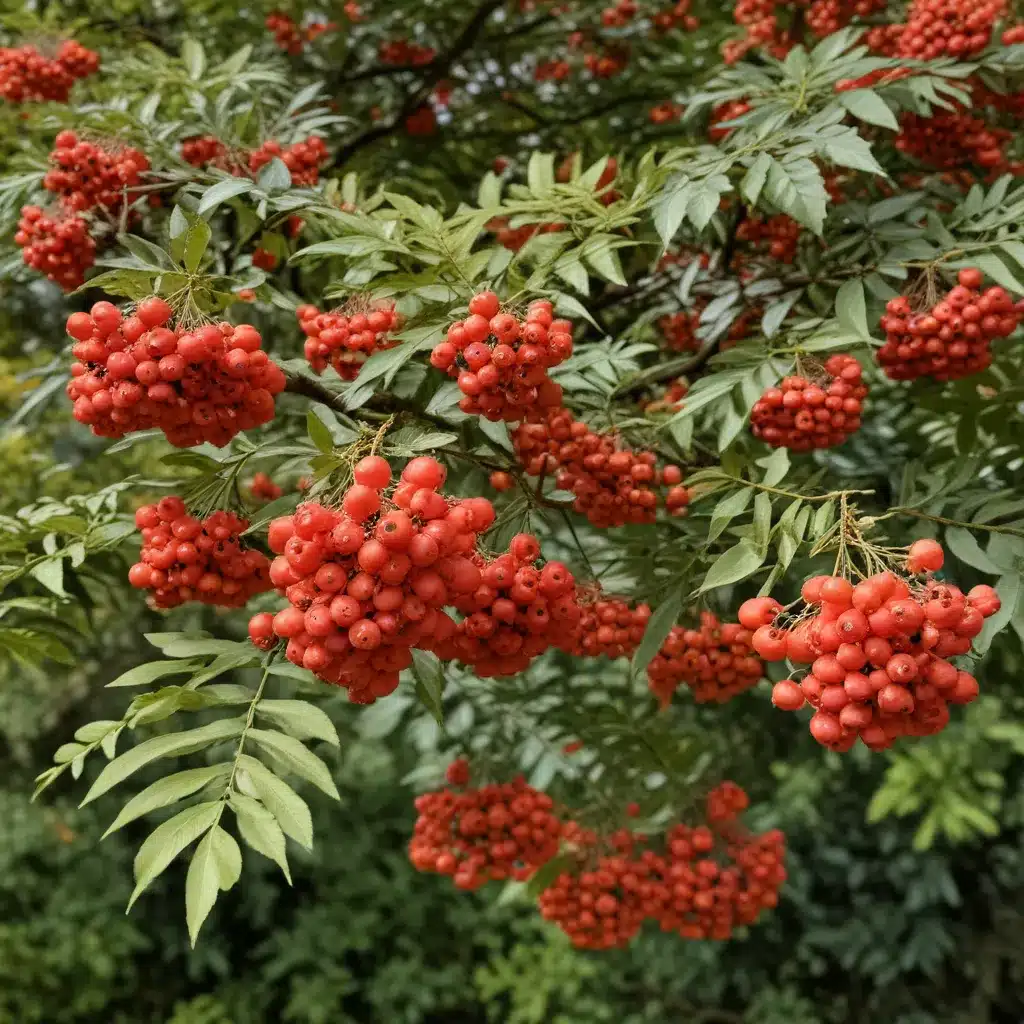
Marveling at the Magnificent Mountain Ash: A Spotlight on This Ornamental Delight
Botany of Mountain Ash
The mountain ash (genus Sorbus) is a diverse group of small deciduous trees and shrubs belonging to the rose family (Rosaceae). With over 100 species distributed across the northern temperate regions of the world, these hardy ornamentals are prized for their vibrant seasonal displays and adaptability to a wide range of growing conditions.
Morphologically, mountain ash species exhibit a characteristic rounded, pyramidal crown and graceful, spreading branches. Their pinnately compound leaves emerge in shades of green, maturing to striking reds, oranges, and purples in the fall. Clusters of white, five-petaled flowers in late spring give way to bunches of brilliant red, orange, or yellow berries that persist well into winter, providing visual interest and sustenance for birds.
Ecological Role of Mountain Ash
Native mountain ash species are found across North America, Europe, and Asia, occupying a diverse array of habitats from boreal forests to high-elevation alpine regions. These hardy trees and shrubs play an important ecological role, providing food and shelter for a variety of wildlife. Their nectar-rich blossoms attract pollinators, while their nutrient-rich berries are a crucial food source for birds, small mammals, and even bears. The dense foliage also offers nesting sites and protective cover for many avian species.
In addition to their value to wildlife, mountain ash make valuable contributions to their native ecosystems. Their deep, fibrous root systems help to stabilize slopes and prevent soil erosion. Some species are even cultivated for reforestation efforts in areas prone to landslides or degradation. By promoting biodiversity and ecosystem health, these versatile ornamentals exemplify the ecological advantages of incorporating trees into the landscape.
Ornamental Applications of Mountain Ash
Beyond their ecological merits, mountain ash cultivars have long been prized for their ornamental appeal in landscaping and horticulture. Their compact, pyramidal habit and graceful branching make them well-suited as specimen trees, accents, or focal points in residential and public gardens. The seasonal color changes of their foliage and berries offer year-round visual interest, while their relatively small stature (typically 20-40 feet tall) allows them to be incorporated into even modest-sized landscapes.
Numerous mountain ash cultivars have been developed to cater to the diverse preferences of gardeners and landscape designers. These include varieties with unique leaf shapes, variegated foliage, or more intense fall coloration. Some cultivars, such as the popular ‘Oakleaf’ mountain ash, have been bred to exhibit a more compact, rounded growth habit, making them well-suited for use as patio trees or in small-scale gardens. Regardless of the specific cultivar, mountain ash remain a beloved and versatile ornamental choice for creating visual impact and seasonal interest in the landscape.
Cultural Significance of Mountain Ash
Mountain ash have long held cultural significance across many Northern Hemisphere civilizations, with their vibrant berries and hardiness inspiring a range of symbolic associations and traditional uses. In European folklore, the mountain ash was believed to possess protective powers, with its wood and berries used to ward off evil spirits and lightning. The tree’s striking autumn foliage and persistent winter berries also made it a popular choice for decorative and ceremonial purposes, such as Yule log decorations and Maypole adornments.
Beyond their symbolic value, mountain ash have also played important roles in the traditional lifeways of many indigenous cultures. In North America, the wood was used to craft tools, furniture, and even canoes, while the berries were a vital food source and medicine for various First Nations peoples. Similarly, in Asia and Europe, mountain ash have long been harvested for their edible fruits, which are often used in jams, jellies, and even fermented beverages.
Horticulture and Cultivation of Mountain Ash
Propagating and cultivating mountain ash is a relatively straightforward process, making them an accessible choice for both professional landscapers and home gardeners alike. Many species can be grown from seed, though vegetative propagation via cuttings or grafting is often preferred to ensure true-to-type cultivars. When planting, mountain ash thrive in well-drained, slightly acidic soils and prefer full sun exposure for optimal growth and flowering.
Ongoing care and maintenance of mountain ash involves regular pruning to maintain their natural form and remove any dead or damaged branches. Watering is essential, especially during periods of drought, to prevent stress and ensure the development of healthy, vibrant foliage and berries. Vigilance against common pests, such as aphids, borers, and leaf miners, is also recommended to keep trees healthy and vigorous.
Challenges and Considerations
Despite their many ornamental and ecological virtues, mountain ash are not without their challenges. Some species are susceptible to various fungal diseases, including fire blight and cedar-apple rust, which can disfigure leaves and compromise the overall health of the tree. Careful selection of disease-resistant cultivars and proactive disease management strategies are essential for successful mountain ash cultivation.
Additionally, mountain ash are not immune to the impacts of climate change, with prolonged droughts, extreme temperatures, and invasive pests posing potential threats to their long-term viability. Gardeners and landscapers must remain attuned to the specific environmental requirements and tolerances of mountain ash species when incorporating them into their designs, ensuring their long-term sustainability within the landscape.
Conclusion
With their vibrant seasonal displays, adaptability to diverse growing conditions, and valuable ecological contributions, mountain ash undoubtedly deserve recognition as a premier ornamental tree. Whether incorporated into residential gardens, public parks, or ecological restoration projects, these versatile beauties offer a myriad of benefits that make them a delight to behold. For the team at TriCounty Tree Care, celebrating the magnificence of the mountain ash is a true passion, and we encourage all who appreciate the natural world to marvel at the splendor of this remarkable species.


